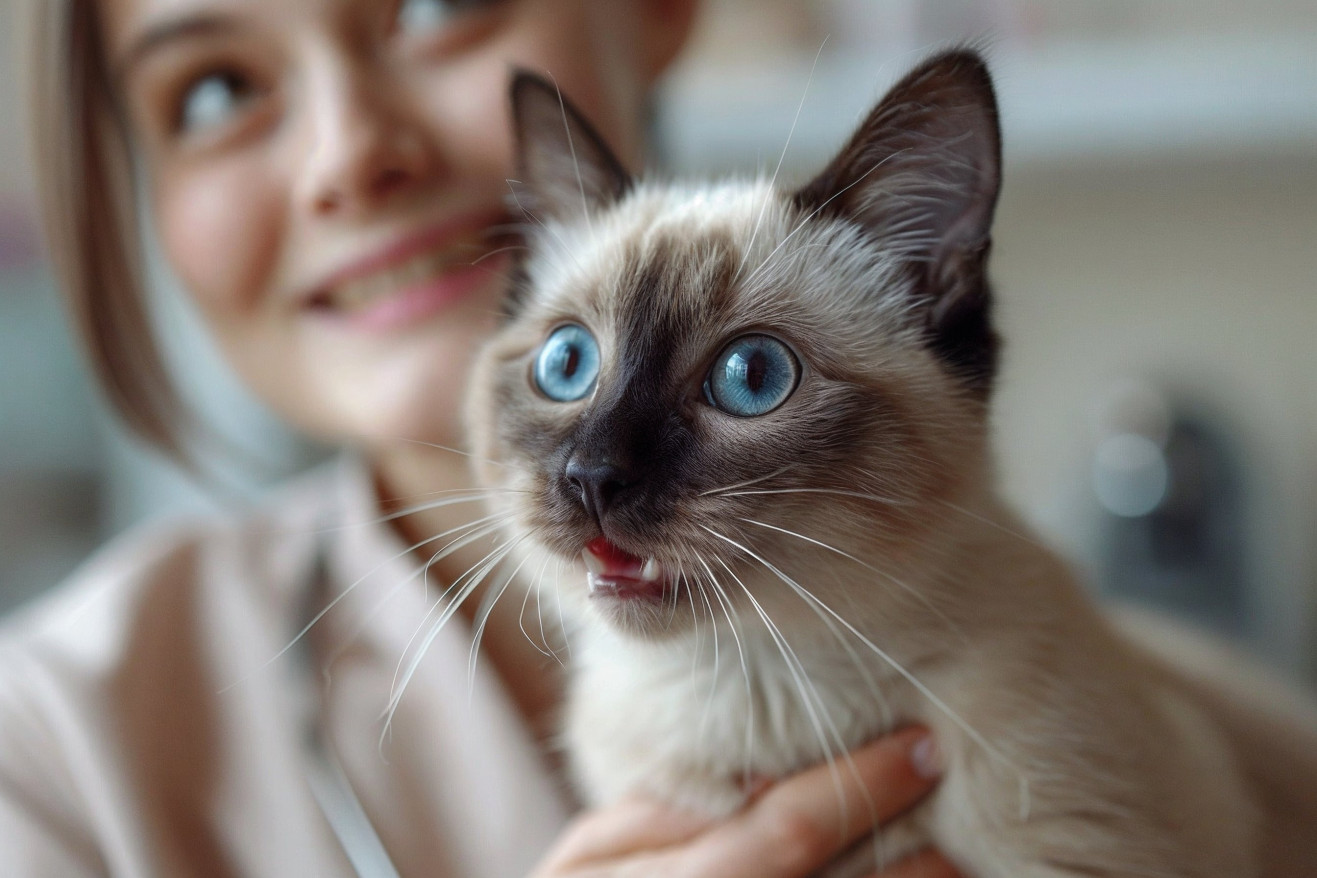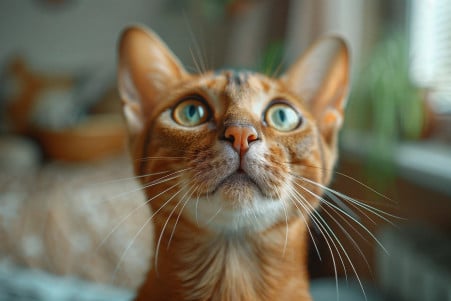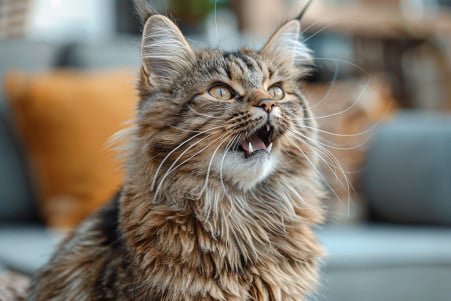Weak and Raspy Cat Meow: Causes and When to See a Vet
11 March 2024 • Updated 11 March 2024

If you’ve noticed that your cat’s meow has become weak and raspy, you may be wondering what’s going on. In cats, a weak and raspy meow can be a sign of laryngitis, upper respiratory infections, nasopharyngeal polyps, thyroid issues, and more. It’s important to take your cat to the vet right away so that the underlying issue can be diagnosed and treated properly.
This article will discuss a variety of clinical perspectives and scientific research on feline vocalization. While we will also consider studies on animal behavior, the focus will be on veterinary research, including the most common medical problems that can lead to a cat’s meow becoming weak or raspy. This information will help you better understand how to respond to changes in your cat’s meow and when to get help from a veterinarian.
What are the causes of a weak and raspy cat meow?
What Is Feline Laryngitis? One of the Most Common Causes
If your cat has a hoarse or weak-sounding meow, it may have laryngitis—an inflammation of the larynx, or voice box, that is often caused by an irritant, infection, or an obstruction in the throat. Signs can be different and may include changes in vocalization, harsh coughing, noisy breathing, a lowered head posture, difficulty swallowing, and bad breath, according to Sharon Lakes.
The diagnostic process will often start with a comprehensive physical exam, and vets may use diagnostic tools like X-rays, bloodwork, or endoscopy to look for obstructions or tumors, according to Apple Valley Vets.
The treatment of laryngitis will depend on the cause. A vet may prescribe a diuretic to help reduce fluid retention, pain medications, or surgery to remove a foreign body.
In addition, supportive care at home, such as using a humidifier, cleaning up nasal discharge, and making dietary changes, can be helpful, according to Sharon Lakes and Memphis Vet. While some cats may need medications or surgery, it’s important to take an individualized approach since every cat is different.
Other Medical Conditions That Can Cause a Cat’s Meow to Be Weak and Raspy
In addition to laryngitis, there are several other medical conditions that can cause a cat’s meow to be weak and raspy, all of which affect the vocal cords and overall health.
Upper Respiratory Infections are one of the most common causes of laryngitis in cats and are characterized by hoarseness, nasal discharge, and sneezing. They are also highly contagious among cats, and bacterial infections may need to be treated with antibiotics, according to Catster.
Another condition, hyperthyroidism, causes the thyroid glands to become enlarged, which can impact the trachea and larynx, leading to a hoarse meow. This condition is diagnosed through bloodwork and is treated with medication for the rest of the cat’s life, according to Cats.com.
Nasopharyngeal polyps are a condition that can cause a cat’s meow to become increasingly raspy over time and can also cause the cat to shake its head or paw at its ears due to discomfort.
In general, veterinarians recommend surgery to remove these polyps. Cats.com also notes that Dr. Pete Wedderburn says that foreign bodies stuck in the throat can cause a hoarse meow, and this is a sign that the cat needs to be taken to the vet immediately to have the object removed.
In general, these conditions are diagnosed through bloodwork, imaging, and sometimes biopsies to determine the exact cause of the condition and the best way to treat it.
In general, treatment can vary from medications that treat infections or thyroid issues to surgical interventions, such as the removal of polyps. This range of treatments is a sign of the different ways that these conditions can manifest and the need for a personalized treatment plan to help a cat maintain its vocal health.
Raspy Cat Meows: Stress and Environmental Impact
A cat’s environment and stress levels can play a big part in how a cat’s meow sounds, and can lead to a meow that sounds weak or hoarse.
Battersea Dogs & Cats Home explains that stress in cats can lead to changes in behavior, which can include changes in vocalization. Cats are very sensitive to their environment, so they may change their meow in response to environmental stress as part of a larger group of stress-related behaviors.
Some signs of stress in cats include excessive vocalization and changes in the pitch and tone of their meows. A study in PMC by Tavernier explains that environmental factors play a big role in the development of feline vocalizations, and that pet cats have more vocal flexibility and vocal repertoire than feral cats. This suggests that domestic cats have adapted their vocalizations to their environment, including their interactions with humans.
To improve a cat’s vocal health and help them overcome stress-related changes in their vocalizations, it’s important to make sure that they’re living in an environment that’s as stress-free and stimulating as possible.
VCA Animal Hospitals suggests that pet parents provide cats with stimulating activities and opportunities for exploration to help them cope with stress. Environmental enrichment can include interactive toys, cat trees, and safe access to the outdoors.
By making changes to the environment to reduce stress, pet parents can help their cats get back to a meow that’s strong and clear, which is a sign of a happy and healthy cat.
Nutritional Requirements for a Healthy Cat Meow
In addition to being a cat’s primary way of communicating with humans, a cat’s meow can also be a sign of its overall health and nutrition.
If a cat is experiencing nutritional deficiencies that impact the throat and vocal cords, it may have a weak or hoarse meow. Tufts Catnip explains that it’s important to make sure a cat’s diet meets the nutritional standards set by the Association of American Feed Control Officials (AAFCO).
Vitamins, minerals, and proteins are all needed for a cat’s growth and bodily functions, and not getting enough of these nutrients can be detrimental. For example, a study by Dr. Cecilia Giulivi published in PMC explains that a lack of vitamin B-6 can disrupt amino acid metabolism, which can lead to vocalization issues and other problems.
Make sure that the diet you choose for your cat provides all the essential nutrients needed to support a healthy vocal apparatus. Make sure that any commercial cat food you buy includes an AAFCO statement that says it is ‘complete and balanced,’ as recommended by NASC LIVE.
Ask your vet for personalized dietary advice or if you’re thinking about adding supplements. Knowing what to look for in a diet can help you make sure that your cat’s meow stays strong and healthy.
The Complex World of Cat Vocalizations: Throat and Vocal Cord Anatomy
The highly specialized anatomy of the cat’s throat and vocal cords is essential to their vocal communication. The larynx, which is located at the back of the throat, houses the vocal cords that are necessary for meowing.
As explained in the Dissection Lab Guide for Dog and Cat Anatomy, the vocal cords vibrate and create sound when air is pushed out of the lungs. The larynx’s anatomy, including the muscles and cartilage that surround it, enables a cat to produce a wide variety of sounds, from quiet purrs to loud meows.
Yet, structural abnormalities such as inflammation and other conditions can cause a cat to have a weak, hoarse meow. For example, laryngitis, which is inflammation of the vocal cords, can disrupt the system and change a cat’s voice.
Moreover, a study highlighted by Earth.com notes that cats that purr tend to have a hyoid bone that is completely ossified, which is a bone that supports the tongue and larynx, and this can affect the sounds a cat makes.
A comprehensive knowledge of the anatomy and physiology of a cat’s vocal cords and throat is important for understanding the potential reasons for changes in a cat’s voice. This knowledge can help pet parents and veterinarians identify when this complex system is being disrupted, which can help ensure that cats receive the care they need to stay healthy and happy.
Final Thoughts: What a Weak or Raspy Meow Means for Your Cat
In this article, we have discussed the many potential causes of a cat’s weak or raspy meow. From laryngitis, as mentioned by the Animal Clinic of Benicia, to upper respiratory infections and more serious issues like hyperthyroidism, there are many things that can affect a cat’s ability to meow. It is important to stress the importance of visiting a vet, which is the first step in getting an accurate diagnosis and treatment plan.
We have also discussed how stress and other environmental factors can affect a cat’s meow, with information from PetMD that says a stress-free environment is important for vocal health. We have also discussed the importance of nutrition in maintaining a cat’s vocal cords.
Understanding and responding to changes in a cat’s meow is important for understanding the anatomy and physiology of a cat’s throat and vocal cords.
In conclusion, it is clear that a cat’s meow is more than just a form of communication—it is an important sign of a cat’s overall health and well-being. Whether it is a change in the tone or frequency of a cat’s meow, it is a sign that should be heeded and may require immediate attention and care.


